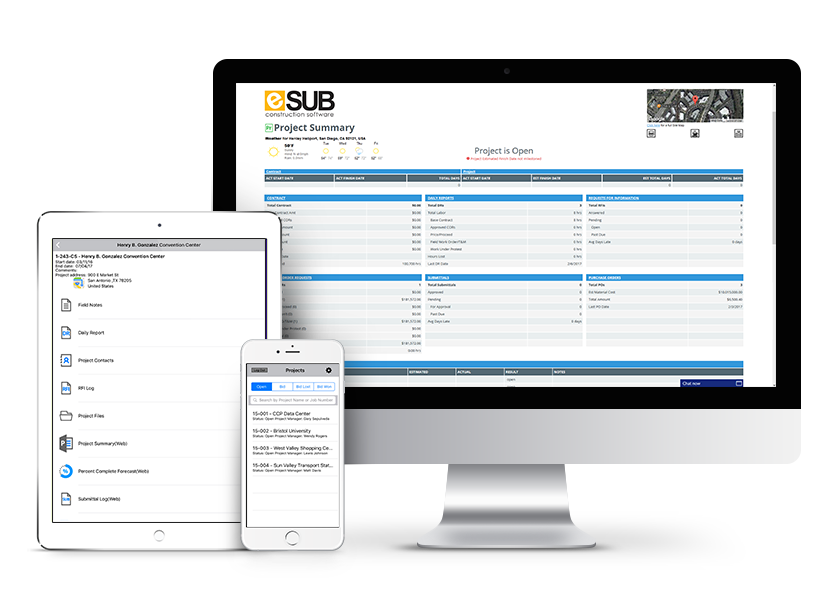
How “Pushing Paper” is Crushing Your Bottom Line
How “Pushing Paper” is Crushing Your Bottom Line
With disruptive technologies such as cloud-based project management and mobile apps making their way onto jobsites, the construction industry has begun to see a dramatic change in how project data is stored and accessed from start to finish.
Traditionally, field workers collected information and brought it back with them to the office (e.g., collecting data for daily reports), or used office-generated information to guide construction (e.g., plans and specifications). Until recently, the industry relied on an outdated process for the distribution of this information, which required workers to manually log and transfer it.
Manual data transfer proved to be extremely time-consuming and expensive, and it became abundantly clear that construction companies had to adapt in order to meet the growing demand for improved operational efficiency. Today, several driving factors are facilitating the implementation of more efficient practices for sharing and accessing project information.
— The cloud and mobile. The development of cloud-based and mobile technologies specifically designed for the construction industry has allowed companies to collaborate more efficiently.
— Doing more with less. A shift has taken place in the construction industry, resulting in more complex projects that need to be completed faster while remaining on or under budget.
— Increased demand for anywhere/anytime information access. An increase in project complexity has created a need for the correct information to be readily available and accessible at all times and from any location.
Table of Contents
Always On! In the Office, at the Construction Site and On the Go.
The construction industry’s adoption of cloud-based solutions has enabled project team members to collaborate as never before, and now its use is spreading like wildfire. Cloud software operates on the principle that an authoritative copy of every file related to a particular project is centrally stored and universally available to the entire team. This means that geographically dispersed teams can collaborate more or less in real time, leading to a more efficient use of resources and fewer logistical errors.
Apps for smartphones and tablets are another technology construction pros are using to operate more efficiently. Prior to the adoption of mobile technology, field workers had to lug cameras, notebooks and drawings to capture data and stay informed, or they were forced to run back to the trailer to consult plans, make notes and send emails. Like cloud software, the rise of mobile technology on the jobsite has enabled workers to collaborate in real time, improving the team’s overall performance. When workers are not tethered to their desks or workstations, they can be onsite answering questions, guiding work and making informed decisions without delay.
However, it is important to remember that while mobile apps on tablets and smartphones bridge the office-field information divide, isolated apps that don’t integrate with other programs can create more information silos. Therefore, the best way to ensure data integrity is to leverage a comprehensive project management system so team members can access, manage and share relevant information without any issues.

How to do More with Less
An increase in project complexity, as well as materials and labor costs, has caused a monumental shift within the construction industry. Today, owners are asking contractors to deliver more complex projects faster, but still on or under budget—essentially asking them to do more with less. Cloud-based and mobile technologies can help contractors meet these demands by not only improving efficiency, but also improving collaboration, which is vital as more complex projects demand more specialized input.
Improved collaboration is changing the way contractors work with subcontractors. Prior to the establishment of this paradigm, a contractor would have never asked for subcontractors’ input. Now because of the need to reduce costs and improve efficiency, a project team is only considered as good as the sum of its parts. In other words, they need to work extremely well together.
For the most part, subcontractors are historically thought to be a hired hand—paid to do a job and not offer suggestions—yet in today’s construction environment, many of them are innovating on par with any company in the industry. This evolving dynamic encourages subcontractors to become more active members of the project workflow, leading to improved collaboration among the project team and throughout the project delivery process.

Cloud-based Project Management & Mobile Access Reduces Complexity
The increase in project complexity seen throughout the construction industry has acted as a catalyst for a number of changes. However, none of these changes matter unless the entire team has access to the most up-to-date project information. Suppose a jobsite requires five printed copies of the master plans, but one day an error is spotted and edited by a member of the project team. Without a solution in place, it’s impractical for the entire team to be quickly aware of the update or have access to the appropriate documents. Consider the additional costs associated with physically reprinting and distributing those five copies of the plans, the time wasted waiting on the revisions to be delivered to the worksite, and the potential errors that could occur as a result of working off outdated plans. In a time when expectations are growing and budgets are shrinking, minor issues such as this can be detrimental to any construction project.
Additionally, eSUB cloud-based solutions enable project teams to generate and archive tremendous amounts of relevant data on the fly. By analyzing this data, companies can identify trends, locate inefficiencies and bottlenecks, and use that information to streamline the project information workflow. This process is critical for project teams because it allows them to create metrics upon which they can measure their success.
As an example, by analyzing the average turnaround time on RFIs and submittals, a company can establish a benchmark from project to project to assess efficiency. While most industries use metrics to ensure a project remains on schedule, the construction industry also uses metrics to ensure a project remains on budget. A majority of construction projects are completed on time, but this requires a tremendous amount of resources that owners are reluctant to provide, especially if doing so increases the budget and reduces profit margins.
By using solutions like eSUB’s project management platform to effectively generate and archive data, companies can better analyze the information workflow to ensure that projects are delivered on time and on budget.
